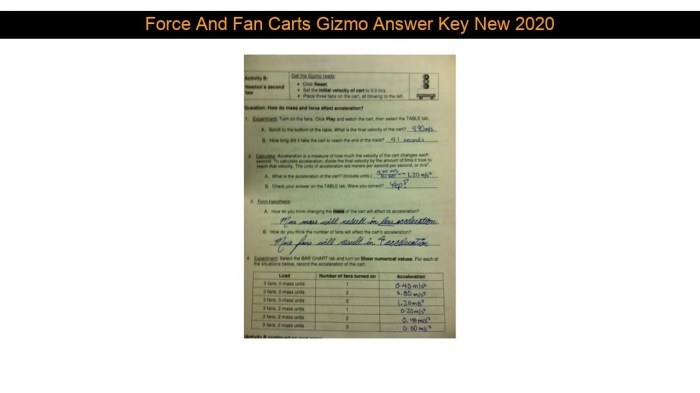Step into the world of physics with the Fan Cart Gizmo Answer Key, your ultimate guide to unraveling the mysteries of motion. This interactive tool empowers you to analyze the movement of the fan cart, providing insights into the fundamental principles that govern our physical world.
Delve into the concepts of motion analysis, explore experimental design, and uncover the applications of this versatile Gizmo in education and research. Get ready to witness the captivating dance of physics as you embark on this enlightening journey.
Fan Cart Gizmo

The Fan Cart Gizmo is an interactive simulation tool that allows students to explore the concepts of motion and energy in a fun and engaging way. It simulates a fan cart on a track, which can be propelled by a fan.
Students can adjust the fan speed, track length, and other variables to investigate how these factors affect the cart’s motion.
Components and Functions
- Fan:The fan provides the force that propels the cart forward.
- Cart:The cart is the object that moves along the track.
- Track:The track provides a surface for the cart to move on.
- Sensors:The sensors measure the cart’s speed and position.
Experiments
Students can use the Fan Cart Gizmo to conduct a variety of experiments, including:
- Investigating the relationship between fan speed and cart speed.
- Determining the effect of track length on cart speed.
- Measuring the acceleration of the cart.
- Calculating the kinetic energy of the cart.
Motion Analysis with the Gizmo
Motion analysis is a crucial aspect of physics, enabling scientists to understand and predict the behavior of moving objects. The Fan Cart Gizmo provides an interactive platform for users to analyze the motion of a fan cart, exploring various concepts and principles related to kinematics.
Types of Motion Analyzed with the Gizmo
The Gizmo allows users to analyze different types of motion, including:
- Constant velocity motion: The fan cart moves at a constant speed in a straight line.
- Accelerated motion: The fan cart’s speed changes at a constant rate.
- Projectile motion: The fan cart is launched into the air and follows a parabolic trajectory.
Data Collection and Analysis
Data collection and analysis are essential parts of the scientific process. In the context of the Fan Cart Gizmo, data collection involves gathering information about the motion of the fan cart. This information can be used to analyze the cart’s motion and determine its characteristics.
There are two main methods for collecting data from the Gizmo: sensors and data loggers.
Sensors
- Sensors are devices that can detect and measure physical quantities, such as position, velocity, and acceleration. In the Fan Cart Gizmo, sensors are used to measure the cart’s position and velocity.
- The position sensor is a light gate that measures the time it takes for the cart to pass through a beam of light. This information can be used to calculate the cart’s velocity.
- The velocity sensor is a motion detector that measures the cart’s velocity as it passes by.
Data Loggers
- Data loggers are devices that can store data collected from sensors. In the Fan Cart Gizmo, the data logger is used to store the data collected from the position and velocity sensors.
- The data logger can be used to download the data to a computer, where it can be analyzed using a variety of software programs.
Analyzing the Collected Data
Once the data has been collected, it can be analyzed to determine the motion characteristics of the fan cart. This can be done using a variety of methods, including:
- Graphical analysis: This involves plotting the data on a graph and examining the shape of the graph to determine the cart’s motion.
- Numerical analysis: This involves using mathematical equations to calculate the cart’s motion characteristics, such as its velocity and acceleration.
- Computer simulations: This involves using computer software to create a model of the fan cart and its motion. The model can be used to predict the cart’s motion under different conditions.
Examples of Different Types of Data
The following are examples of different types of data that can be collected and analyzed from the Fan Cart Gizmo:
- Position vs. time: This graph shows the position of the cart as a function of time. The slope of the graph represents the cart’s velocity.
- Velocity vs. time: This graph shows the velocity of the cart as a function of time. The slope of the graph represents the cart’s acceleration.
- Acceleration vs. time: This graph shows the acceleration of the cart as a function of time. The area under the graph represents the cart’s change in velocity.
Experiment Design and Implementation
Experimentation lies at the heart of scientific inquiry, allowing us to uncover the relationships between variables and test hypotheses. To ensure the validity and reliability of our findings, it is crucial to adhere to sound principles of experimental design.
In search of the elusive fan cart gizmo answer key? Look no further! While you’re at it, don’t forget to check out pathway 1.0 chick fil a for some tantalizing treats. Once you’ve indulged in culinary delights, come right back here to crack that fan cart gizmo answer key wide open!
Variables are the factors that can change or be manipulated in an experiment. They are typically classified into independent and dependent variables. The independent variable is the one that the experimenter changes or controls, while the dependent variable is the one that is measured and observed.
Controls are essential for eliminating or minimizing the effects of extraneous variables that could confound our results. By keeping all other variables constant except for the independent variable, we can isolate its effect on the dependent variable.
Hypotheses are predictions about the relationship between variables. They provide a framework for designing and conducting experiments and guide our interpretation of the results.
Using the Fan Cart Gizmo
The Fan Cart Gizmo is a powerful tool for designing and implementing experiments in mechanics. It allows us to manipulate variables such as fan speed, cart mass, and distance, and measure the resulting motion of the cart.
To design an experiment using the Gizmo, we first need to identify the independent and dependent variables and formulate a hypothesis. We then set up the Gizmo according to our experimental design, ensuring that all controls are in place.
Once the experiment is set up, we collect data by running the simulation and recording the values of the dependent variable for different values of the independent variable. We can then analyze the data to test our hypothesis and draw conclusions about the relationship between the variables.
Examples of Experiments
- Effect of Fan Speed on Cart Velocity:Hypothesis: Increasing the fan speed will increase the velocity of the cart.
- Effect of Cart Mass on Cart Acceleration:Hypothesis: Increasing the mass of the cart will decrease its acceleration.
- Effect of Distance on Cart Velocity:Hypothesis: Increasing the distance between the fan and the cart will decrease the velocity of the cart.
Applications and Extensions: Fan Cart Gizmo Answer Key
The Fan Cart Gizmo offers diverse applications in physics education and research. It serves as an invaluable tool for demonstrating and investigating real-world phenomena, enhancing student comprehension of fundamental physics principles.
Educational Applications, Fan cart gizmo answer key
The Fan Cart Gizmo is extensively used in classrooms to:
- Illustrate the concepts of motion, force, and energy.
- Investigate the relationship between velocity, acceleration, and displacement.
- Demonstrate the effects of friction and air resistance.
- Explore the principles of momentum and impulse.
Research Applications
In research settings, the Fan Cart Gizmo has been employed to:
- Study the dynamics of wheeled vehicles.
- Investigate the effects of surface conditions on motion.
- Develop and test new motion sensors and data acquisition systems.
FAQ Corner
What is the purpose of the Fan Cart Gizmo?
The Fan Cart Gizmo is a virtual tool that allows users to analyze the motion of a fan cart, providing insights into concepts such as velocity, acceleration, and force.
How can I use the Gizmo to design experiments?
The Gizmo provides a platform to design and implement experiments, allowing you to manipulate variables and test hypotheses related to motion.
What types of data can I collect using the Gizmo?
The Gizmo enables you to collect data on position, velocity, and acceleration, which can be analyzed to determine the motion characteristics of the fan cart.
